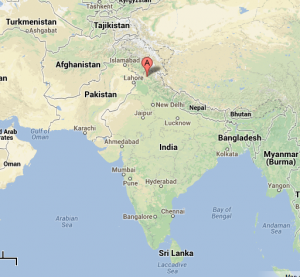 John McCarthy and Sam Bradley are collaborating to develop an earthquake awareness and disaster resilience program for vulnerable communities in Dharamsala, India. The region is predicted to have an extremely large earthquake in the next 50 years and they are looking to raise awareness, develop community programs and improve the resilience capacity for the population. John and Sam both have Master’s degrees in Geophysical Hazards and are looking to further their careers in natural hazards, DRR and resilience.
John McCarthy and Sam Bradley are collaborating to develop an earthquake awareness and disaster resilience program for vulnerable communities in Dharamsala, India. The region is predicted to have an extremely large earthquake in the next 50 years and they are looking to raise awareness, develop community programs and improve the resilience capacity for the population. John and Sam both have Master’s degrees in Geophysical Hazards and are looking to further their careers in natural hazards, DRR and resilience.
Nestled in the foothills of the Himalayas sits the political and cultural centre of the Tibetan refugee community. Since the Chinese invasion of Tibet in 1959, His Holiness the 14th Dalai Lama and the Tibetan Government have resided in exile in McLeod Ganj, Dharamsala.
Residents of this region are subject to a host of natural hazards as well as a large range of socio-economic issues that have left much of the local community vulnerable to potential disasters. The region has been assigned a zone V, the highest rating of earthquake risk in India and is subject to the annual Monsoon and associated flash flooding which can give rise to landslides. The region also plays host to man-made and natural forest fires during the summer months.
The last major earthquake to affect the region was the 1905 Kangra earthquake with a magnitude (MW) 7.8. The earthquake devastated the region, killing nearly 20,000 people and reducing 100,000 dwellings to rubble. The region was left with a depleted population until the arrival of the displaced Tibetans from 1959 onwards. Since then, the centre of Dharamsala has been rebuilt and is home to nearly 14,000 Tibetans and 20,000 Indians.
The displaced Tibetans face further problems with population rates exceeding rates of economic development. Many of the refugees face difficulties in obtaining work and as such are dependent on the tourism industry that is centred on Dharamsala. Up to 2,500 refugees migrate over the border of China to Nepal, with many moving to the cultural centre each year to escape persecution, adding further burden to already strained resources. Although there is a high rate of literacy amongst Tibetans, they have a very high drop out rate from schooling and can rarely afford to seek higher education, leaving the community reliant on income from tourism and the service industry. Tibetans in India are also unable to gain citizenship; they cannot vote, carry a passport or legally purchase land for development. This leaves them vulnerable and socially isolated.

Houses built on steep slopes in Dharamsala. Source Wikicommons
Under international law, the Indian government is not liable for implementing disaster risk reduction (DRR) or post disaster relief for the Tibetan community. As such, the current disaster management structure is poor. There is very little in the way of DRR awareness and many campaigns have been largely forgotten. The community has a low understanding of earthquake risks and as such, there is limited preparedness, limited response and a distinct lack of community trust in local Government Authorities to act in the event of a disaster. Any large earthquake in the future could leave the Tibetan community and large parts of its cultural heritage at risk.
The geologically complex region forms part of the convergence zone between the Indian and Eurasian plates. The Indian plate has been moving northwards into the Eurasian plate at a rate of 40mm/yr and has caused several large earthquakes in the last 15 years alone, namely Gujarat (Mw 7.7) in 2001, which killed 20,000 people and Kashmir (Mw 7.6) in 2005, killing 86,000 as well as the earthquakes in Eastern Iran during April this year.
The Dharamsala region contains two major thrust faults running parallel to the length of the Himalayan range. There are two large seismic gaps (parts of active faults that have not produced any activity in a long time) on either side of Dharamsala where a high accumulation of strain has built up due to several years of low activity. There is a large slip deficit of up to 16 metres. Although there are frequent minor shocks in the region, a future earthquake could exceed Mw 8.6.
Here, we come to the old adage that ‘earthquakes don’t kill people, buildings do’. Many of the buildings were constructed in the late 1950’s and early 60’s with the influx of Tibetan refugees. Many buildings were built very quickly using the cheapest materials possible and with no adherence to building codes. As a result, many dwellings are constructed using brittle concrete and unburnt bricks with very heavy rooftops that are susceptible to cracking and collapse under the shear forces produced by an earthquake. Many dwellings have had further stories added as the region became more populated and tourism has flourished adding to further instability. Many of these buildings have placed large water storage tanks (1000 litres+) on rooftops adding further weight and vulnerability. In addition to all of these problems and poor planning, many buildings are situated on the slopes steeper than 45° on poorly compacted soils that are prone to earthquake and water induced landslides.
The only building that has been retrofitted for earthquake resistance thus far is the Library of Tibetan Works and Archives. All other buildings are yet to be assessed and retrofitted due to the high cost and dependence on donor funding.
Our project is looking at all aspects of resilience within the community to earthquake-based disasters and further secondary hazards such as earthquake induced landslides. We are investigating methods to develop earthquake awareness programs, community DRR planning and implementation, response efforts and promote multi-stake holder participation to reduce the vulnerability of this community and further communities in the region.
We are also looking at ways to reduce casualties through retrofitting programs. Our investigations will explore cost effective and simple solutions to make dwellings resistant to the shear forces produced in earthquake situations and hence collapse.
We would like to reach out to design engineers, architects and NGOs that are involved with earthquake engineering and community resilience to earthquakes and their manifold effects. We would welcome any advice or comments on the technical and social aspects of our proposed project. Comments can be left using the comments box at the bottom of this article, or by contacting us via email (jpmc_mccarthy@hotmail.com or sambradley@me.com).


MR
Interesting article. As a occasional visitor to Dharamsala, it’s a constant worry of mine yet I have yet to hear about any awareness programs/efforts or discussions within the Tibetan community. Perhaps such information can be given out through pamphlet distributions or awareness events where people (including locals/volunteers/youth) can gain more of an insight on what can be done.